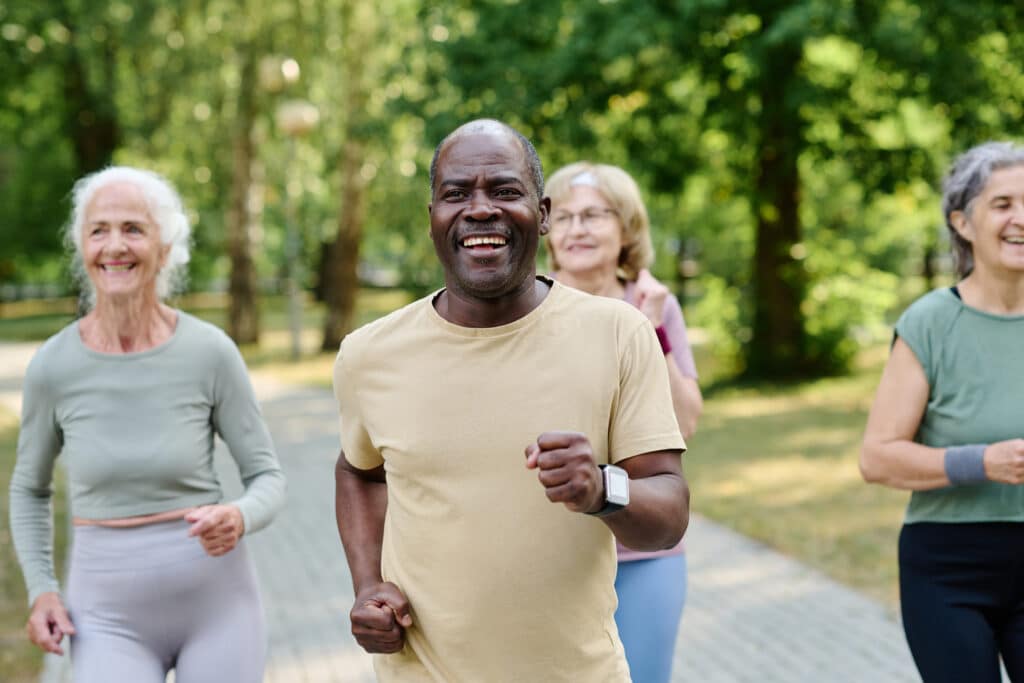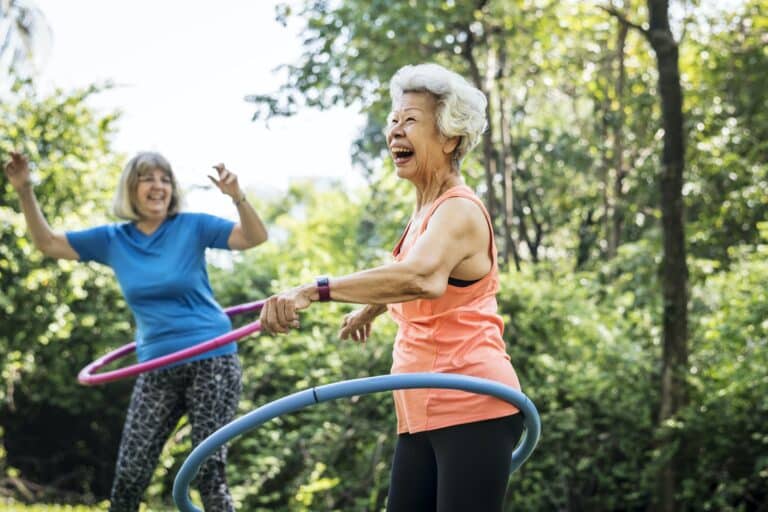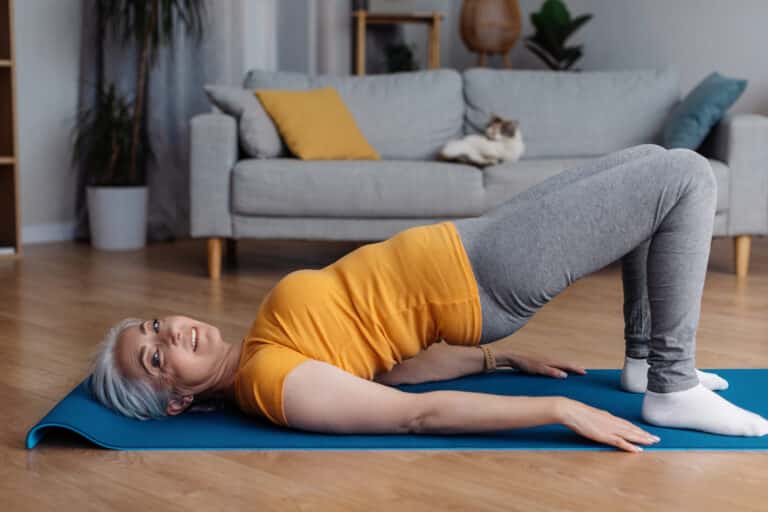If you’re new to exercise or working out for the first time in a long time, you’re probably curious about how hard you should exercise.
As we age, maintaining an active lifestyle becomes increasingly crucial to our overall health and well-being. Research indicates regular physical activity can help manage chronic conditions, improve mobility, and enhance mood.1
But how can we ensure we’re exercising at the right intensity? This article aims to answer some of these important questions to ensure you see safe and enjoyable progress in your long fitness journey.
Understanding Exercise Intensity
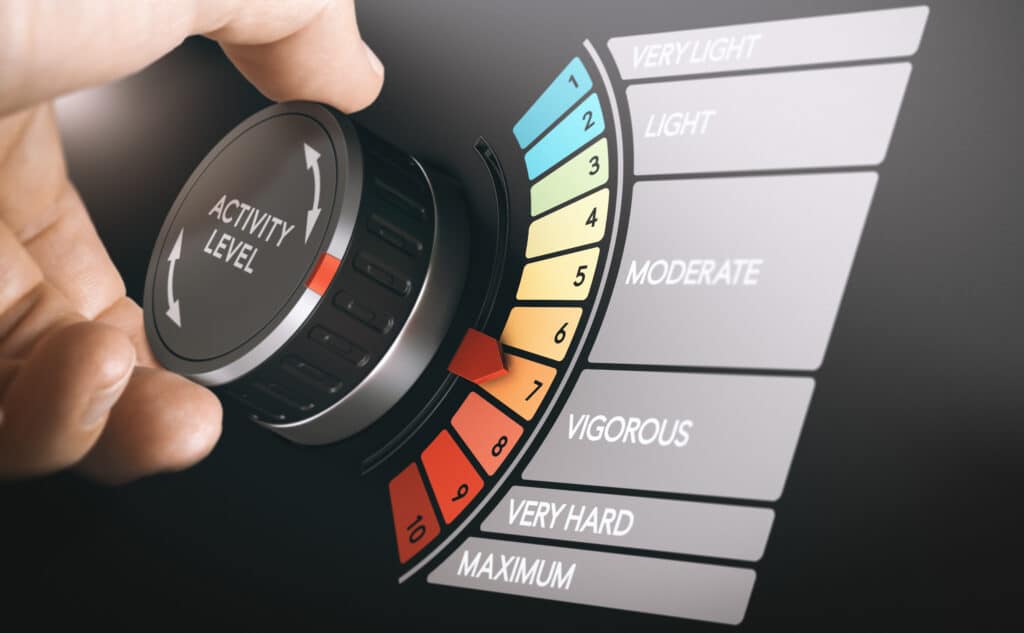
A common myth I’ve encountered in my practice is that only high-intensity workouts provide health benefits. This is not true. While high-intensity workouts have their time and place, moderate and light-intensity exercises can significantly improve health and fitness.
So what body signals do we need to understand to push ourselves harder—or perhaps more importantly, when should we pump the brakes?
In the fitness world, exercise intensity refers to how hard your body works during physical activity. It’s determined by various factors, including your heart rate, breathing rate, sweating, and muscle fatigue.
The Perceived Exertion Scale and Target Heart Rate calculation can be helpful here. They can guide you to exercise safely and effectively at an intensity level that’s right for you.
Listening to Your Body with the Perceived Exertion Scale
The Perceived Exertion Scale is a tool that helps you gauge how hard you feel like your body is working.
It’s based on the physical sensations you experience during physical activity, such as increased heart rate, respiration or breathing rate, sweating, and muscle fatigue.
The best part of the PES is that it’s all about how you perceive your effort, not someone else’s arbitrary standard. That’s why it’s a beautiful tool for older adults keen to improve their fitness levels without overdoing it.
One popular perceived exertion scale is the Borg Rating of Perceived Exertion (RPE), which ranges from 6 (no exertion at all) to 20 (maximum exertion). To use it, you would rate how hard you feel your body feels like it is working based on your internal gauge on a scale of 6-20.
For instance, on a scale of 6-20, walking in the park might be a 9 (very light), while a high-intensity boot camp could be a 17 (very hard). The goal is to find your ‘sweet spot’ where you’re challenging yourself but not pushing to the point of discomfort or pain.2
Finding the Borg scale a little confusing? To simplify the concept, we encourage you to think about a simple 1-10, with 1 being doing no activity and 10 being extremely challenging, like running up a steep hill.
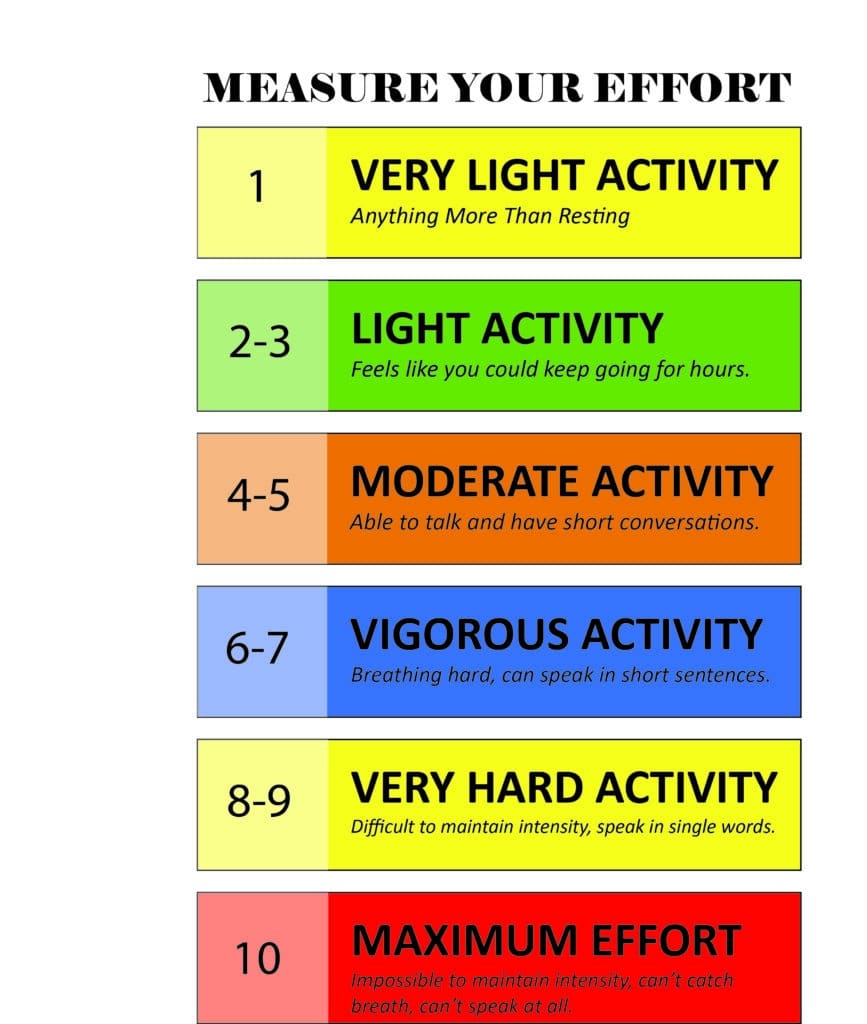
Ideally, you find yourself somewhere between 3-7 under most circumstances, as too much or too little can negatively impact your progress.
Target Heart Rate: The Mathematical Approach
While the Perceived Exertion Scale relies on your subjective feelings, calculating your Target Heart Rate (THR) is more objective in monitoring exercise intensity.
Your target heart rate is the range of heartbeats per minute where your workout is most beneficial. It’s like your body’s built-in fitness tracker, helping you gauge if you’re pushing too hard or not hard enough.
Calculating your target heart rate may sound like a task for scientists, but it’s surprisingly straightforward.
How to Find Your Target Heart Rate
First, subtract your age from 220 to estimate your maximum heart rate. For example, if you’re 60 years old, your target heart rate would be 160.
We should note that the easiest way to track your heart rate is with a fitness monitor, which can be purchased online or at many large retail chains.
The Latest Fitbit Does WAY More Than Just Tracking Steps
The Fitbit Charge 6 is our top recommendation for fitness trackers. During testing we had very good results with the accuracy of the heart rate monitor, just as with the previous model. The Charge 6 syncs to the Fitbit app on your phone, providing a clear, understandable analysis of your data. Beyond steps, you can choose to track 41 different exercises—everything from golf to kayaking.
Other vitals the Fitbit Charge 6 can measure are your sleep stages, heart rate, blood oxygen level, and temperature variation throughout the night. The Fitbit Charge 6 can even help you understand your sleep patterns and habits, and make changes to sleep better and feel more refreshed.
Overall, we feel the Fitbit Charge 6 is the best device for older adults who want to improve their health and fitness. It is easy to use, well designed, and reliable, and simply does so much for a very reasonable price.
Our recommendations are the same items we trust and prescribe to patients. When you buy through links like this on our site, we may earn an affiliate commission to support new content.
Using Your Target Heart Rate Measurement
Once you have determined your target heart rate, you can use it to determine how hard and for how long you should exercise. This takes a bit of calculation, but if you’re not good at math, you only need a calculator (like the one at this link) or the calculator on your phone.
For moderate-intensity physical activity, your target heart rate should be between 50% and 70% of your maximum heart rate. In contrast, vigorous-intensity activity should be between 70% and 85%.3
Let’s take an example. If you’re 65, your maximum heart rate is 155 beats per minute. During a moderate-intensity workout, aim for a heart rate between 78 (50% of 155) and 108 (70% of 155).
Remember, these numbers are not set in stone. They are guidelines to help you tailor workout intensity based on your fitness levels. Aim for the lower end of the target heart rate range if you’re new to exercise. As your fitness improves, gradually increase the intensity.
Understanding workout intensity helps you navigate the journey, ensuring you’re on the right track without veering off into the discomfort zone.
The beauty of these two methods is that they can be used individually or together, providing a comprehensive way to monitor your exercise intensity. Understanding and applying these concepts can help you exercise more effectively, improving health outcomes as you age.
Remember, it’s always wise to consult a healthcare professional before starting any new exercise regimen.
Strength Training Basics for Older Adults

As we age, our bodies naturally lose muscle mass and bone density. These processes are known as sarcopenia and osteopenia, respectively. But we can also combat muscle and bone loss with strength training.
Strength training can help older adults maintain or even increase muscle mass and improve bone density.4
This is crucial because it enhances your overall functional capacity. You’ll be better able to perform daily tasks, like lifting groceries, climbing stairs, or even getting up from a chair.
How Much Weight Should I Lift?
But how should you approach strength training? Is it the same as when you were in your twenties? The answer is both yes and no.
The principle is the same: by challenging your muscles with resistance, you trigger a process called hypertrophy – your muscle cells grow in size, increasing strength and muscle mass.
However, how you apply this principle changes as you age, primarily to ensure safety. Research suggests that older adults should perform repetitions to exhaustion within 10-15 reps per set.5
This means choosing a weight that allows you to perform at least 10 reps but at most 15. The weight is too light if you can do more than 15 reps. Conversely, if you can’t do at least 10 reps, the weight might be too heavy, increasing your risk of injury.
How Should I Measure My Exertion While Strength Training?
Can you use the same perceived exertion scale and heart rate calculations for strength training as you can for cardio? You can certainly use the rating of perceived exertion to measure how hard you are pushing during your sets.
Having a heart rate goal is also appropriate to ensure you are not pushing at too high of an intensity during your strength training. Similarly to your cardio exercise, monitoring your heart rate throughout strength workouts is important to avoid overexertion.
The main difference with strength training is that it’s very important to ensure you are breathing steadily throughout the movements. Straining and holding your breath can lead to blood pressure spikes which can be dangerous for some people.
This balance between intensity and safety is critical. Pushing yourself to fatigue within this range will challenge your muscles enough to promote growth but not so much that it puts you at risk.
Remember, our goal here isn’t to become a bodybuilder or powerlifter. It’s to maintain health, improve our quality of life, and stay independent and active as we age.
Strength training, done correctly, can be a powerful tool in your health and wellness toolkit. Let’s not let the rust settle in. Instead, let’s keep our bodies strong, capable, and ready for whatever life offers.
Embracing Rigorous Exercise as a Senior
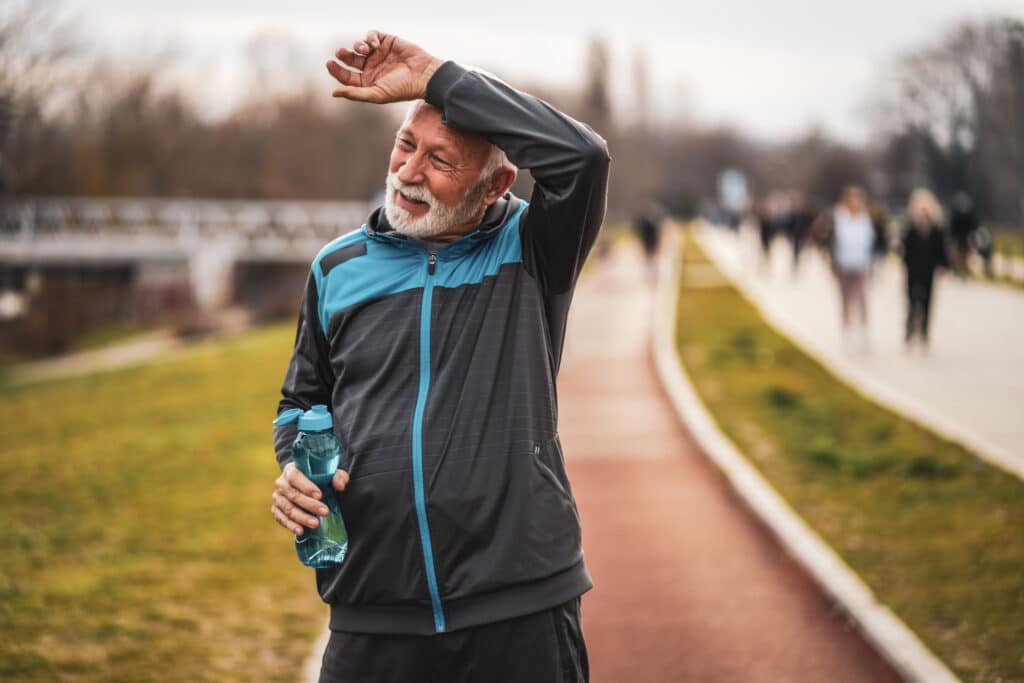
As a healthcare professional with many years of patient interaction, I’ve come across a common misconception that’s all too prevalent among older adults—the notion that rigorous exercise is harmful or unnecessary as we age.
This couldn’t be farther from the truth. Regular and somewhat vigorous exercise can significantly improve overall health and longevity in older adults.6
So, let’s dispel this myth and shed light on the benefits of regular, rigorous exercise.
Challenging physical activity helps maintain or even increase muscle mass, combatting the natural processes of sarcopenia (muscle loss) and osteopenia (bone loss). This is crucial to enhance overall functional capacity, enabling older adults to perform daily tasks more easily, from lifting groceries to climbing stairs.
Additionally, rigorous exercise improves mood, increases mobility, and improves the management of chronic conditions. Far from being a detriment, regular, high-intensity exercise emerges as a powerful tool to enhance the quality of life, promote independence, and ensure a solid and capable body well into the golden years.7
What Does “Rigorous” Mean?
Rigorous exercise for older adults is defined by activities that challenge the body’s cardiovascular and muscular systems, pushing beyond moderate intensity.
While the definition of rigorous can vary based on an individual’s fitness level, health condition, and personal preferences, it generally involves engaging in physical activities that significantly elevate heart rate, breathing, and exertion levels.
For older adults, rigorous exercise may include brisk walking, jogging, cycling, swimming, or participating in high-intensity interval training (HIIT) routines. Lifting weights and similar resistance exercises can also be considered rigorous when performed with sufficient intensity.
Notably, the key is to tailor the intensity of the exercise to the individual’s capabilities and health status. What may be considered rigorous for one person might not be the same for another.
Older adults must listen to their bodies, gradually increase intensity based on their fitness levels, and ensure that the chosen activities align with their overall health and any pre-existing medical conditions.
Knowing When to Take a Break
Just as important as pushing your limits is understanding when to pull back. Overexertion is not a badge of honor; it’s a sign that you’re not listening to your body.
Signs of overexertion can include excessive fatigue, decreased performance, and increased resting heart rate. It’s crucial to be mindful of these signs and take necessary rest days to allow your body time to recover and rejuvenate.
Exercising Around an Injury
Safety should always come first regarding exercise, especially when dealing with an injury. It’s a delicate balance; you don’t want to exacerbate the injury but don’t want to become stagnant. I have worked with many patients who have successfully navigated this tricky terrain in my years of practice.
For instance, if you recently sprained your ankle, focus on upper-body exercises or low-impact activities like swimming. Always consult your physician or a physical therapist before starting a new exercise regimen, mainly if you’re dealing with an injury.
Exercising the strong, healthy parts of your body while resting and nurturing the injured ones is often called relative rest.
It’s also important to note that exercising with cardiac conditions will require closer guidance from your doctor, modifications to your exertion levels, and careful monitoring of your heart rate and blood pressure.
Remember, aging doesn’t mean you have to slow down. With the right approach, you can maintain a robust and healthy body well into your golden years.
Summary
In this exploration of exercise intensity, we’ve debunked the myth that effective workouts are only for the young or extremely fit. With the Perceived Exertion Scale and Target Heart Rate calculations, it’s clear that exercise is adaptable for all ages, emphasizing the importance of strength training to combat muscle and bone loss. Rigorous exercise, tailored to individual capabilities, is not only possible but beneficial for enhancing overall health and maintaining independence. Let’s embrace a balanced approach to fitness, recognizing our limits and challenging them wisely to enjoy a vibrant, active life.
Key Takeaways
- Exercise Intensity Matters: Both moderate and light-intensity exercises can significantly improve health and fitness, not just high-intensity workouts.
- Listen to Your Body: Utilize the Perceived Exertion Scale and Target Heart Rate calculations to exercise safely and effectively, ensuring you’re working at an intensity that’s right for you without overdoing it.
- Perceived Exertion Scale: A subjective measure based on how hard you feel your body works, allowing for personalized exercise intensity without complex equipment.
- Target Heart Rate: An objective way to monitor exercise intensity, ensuring you’re in the ideal range for benefiting your health without pushing too hard.
- Strength Training for Older Adults: Essential for combating muscle and bone loss, strength training should be tailored to perform repetitions to exhaustion within a safe range of 10-15 reps per set.
- Rigorous Exercise Benefits: Regular, challenging physical activity can significantly improve muscle mass, mobility, and mood, proving essential for health and longevity in older adults.
- Safety First: Always consult a healthcare professional before starting any new exercise regimen, especially if dealing with chronic conditions or injuries.
- Adaptation and Injury: Exercise around injuries by focusing on non-affected areas or opting for low-impact activities, always under medical guidance.
- Age Is Just a Number: With the right approach, older adults can maintain robust health and independence through tailored, intensive exercise routines.
References
- Borg G. A. (1982). Psychophysical bases of perceived exertion. Medicine and science in sports and exercise, 14(5), 377–381.
- Warburton, D. E., Nicol, C. W., & Bredin, S. S. (2006). Health benefits of physical activity: the evidence. CMAJ : Canadian Medical Association journal = journal de l’Association medicale canadienne, 174(6), 801–809. https://doi.org/10.1503/cmaj.051351
- Sebastian, L. A., Reeder, S., & Williams, M. (2015). Determining target heart rate for exercising in a cardiac rehabilitation program: a retrospective study. Journal of Cardiovascular Nursing, 30(2), 164-171.
- Lexell J. (1995). Human aging, muscle mass, and fiber type composition. The journals of gerontology. Series A, Biological sciences and medical sciences, 50 Spec No, 11–16. https://doi.org/10.1093/gerona/50a.special_issue.11
- Phillips, B. E., Williams, J. P., Greenhaff, P. L., Smith, K., & Atherton, P. J. (2017). Physiological adaptations to resistance exercise as a function of age. JCI insight, 2(17), e95581. https://doi.org/10.1172/jci.insight.95581
- Lee, I. M., Hsieh, C. C., & Paffenbarger, R. S., Jr (1995). Exercise intensity and longevity in men. The Harvard Alumni Health Study. JAMA, 273(15), 1179–1184.
- Xu, L.; Gu, H.; Cai, X.; Zhang, Y.; Hou, X.; Yu, J.; Sun, T. The Effects of Exercise for Cognitive Function in Older Adults: A Systematic Review and Meta-Analysis of Randomized Controlled Trials. Int. J. Environ. Res. Public Health 2023, 20, 1088. https://doi.org/10.3390/ijerph20021088

